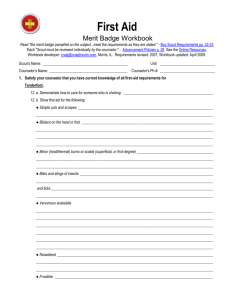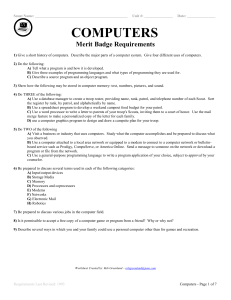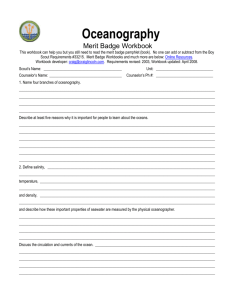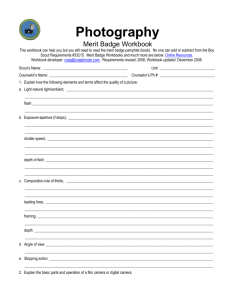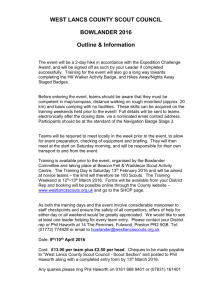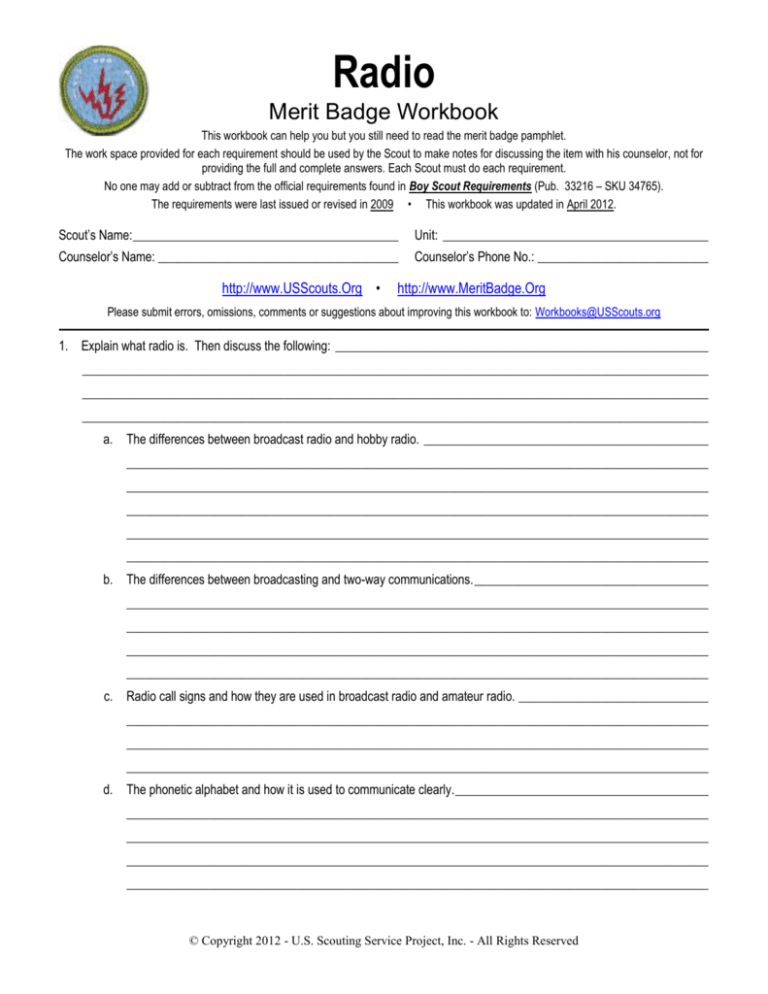
Radio
Merit Badge Workbook
This workbook can help you but you still need to read the merit badge pamphlet.
The work space provided for each requirement should be used by the Scout to make notes for discussing the item with his counselor, not for
providing the full and complete answers. Each Scout must do each requirement.
No one may add or subtract from the official requirements found in Boy Scout Requirements (Pub. 33216 – SKU 34765).
The requirements were last issued or revised in 2009 • This workbook was updated in April 2012.
Scout’s Name:__________________________________________
Unit: __________________________________________
Counselor’s Name: ______________________________________
Counselor’s Phone No.: ___________________________
http://www.USScouts.Org •
http://www.MeritBadge.Org
Please submit errors, omissions, comments or suggestions about improving this workbook to: Workbooks@USScouts.org
______________________________________________________________________________________________________________________________________________
1. Explain what radio is. Then discuss the following: ___________________________________________________________
___________________________________________________________________________________________________
___________________________________________________________________________________________________
___________________________________________________________________________________________________
a. The differences between broadcast radio and hobby radio. _____________________________________________
____________________________________________________________________________________________
____________________________________________________________________________________________
____________________________________________________________________________________________
____________________________________________________________________________________________
____________________________________________________________________________________________
b. The differences between broadcasting and two-way communications. _____________________________________
____________________________________________________________________________________________
____________________________________________________________________________________________
____________________________________________________________________________________________
____________________________________________________________________________________________
c. Radio call signs and how they are used in broadcast radio and amateur radio. ______________________________
____________________________________________________________________________________________
____________________________________________________________________________________________
____________________________________________________________________________________________
d. The phonetic alphabet and how it is used to communicate clearly. ________________________________________
____________________________________________________________________________________________
____________________________________________________________________________________________
____________________________________________________________________________________________
____________________________________________________________________________________________
© Copyright 2012 - U.S. Scouting Service Project, Inc. - All Rights Reserved
Radio
Scout's Name: ________________________
2. Do the following:
a. Sketch a diagram showing how radio waves travel locally and around the world.
Explain how the broadcast radio stations, WWV and WWVH can be used to help determine what you will hear when
you listen to a shortwave radio? __________________________________________________________________
____________________________________________________________________________________________
____________________________________________________________________________________________
b. Explain the difference between a DX and a local station. _______________________________________________
____________________________________________________________________________________________
____________________________________________________________________________________________
____________________________________________________________________________________________
Discuss what the Federal Communication Commission (FCC) does and how it is different from the International
Telecommunication Union.
FCC: _______________________________________________________________________________________
____________________________________________________________________________________________
____________________________________________________________________________________________
____________________________________________________________________________________________
____________________________________________________________________________________________
International Telecommunication Union: ____________________________________________________________
____________________________________________________________________________________________
____________________________________________________________________________________________
____________________________________________________________________________________________
____________________________________________________________________________________________
Radio - Merit Badge Workbook
Page. 2 of 12
Radio
Scout's Name: ________________________
3. Do the following:
a. Draw a chart of the electromagnetic spectrum covering 100 kilohertz (kHz) to 1000 megahertz (MHz).
b. Label the MF, HF, VHF, UHF, and microwave portions of the spectrum on your diagram.
c. Locate on your chart at least eight radio services such as AM and FM commercial broadcast, citizens band (CB),
television, amateur radio (at least four amateur radio bands), and public service (police and fire).
100kHz
1MHz
10MHz
100MHz
1000MHz
4. Explain how radio waves carry information. _________________________________________________________________
___________________________________________________________________________________________________
___________________________________________________________________________________________________
___________________________________________________________________________________________________
Include in your explanation: transceiver, transmitter, amplifier, and antenna.
Transceiver: _________________________________________________________________________________________
___________________________________________________________________________________________________
Transmitter: _________________________________________________________________________________________
___________________________________________________________________________________________________
Amplifier: ___________________________________________________________________________________________
___________________________________________________________________________________________________
Antenna: ___________________________________________________________________________________________
___________________________________________________________________________________________________
5. Do the following:
a. Explain the differences between a block diagram and a schematic diagram.
Block diagram: ________________________________________________________________________________
____________________________________________________________________________________________
Schematic diagram: ____________________________________________________________________________
____________________________________________________________________________________________
Radio - Merit Badge Workbook
Page. 3 of 12
Radio
Scout's Name: ________________________
b. Draw a block diagram for a radio station that includes a transceiver, amplifier, microphone, antenna, and feed line.
c. Explain the differences between an open circuit, a closed circuit, and a short circuit.
Open circuit: _________________________________________________________________________________
____________________________________________________________________________________________
____________________________________________________________________________________________
Closed circuit: ________________________________________________________________________________
____________________________________________________________________________________________
____________________________________________________________________________________________
Short circuit:__________________________________________________________________________________
____________________________________________________________________________________________
____________________________________________________________________________________________
d. Draw eight schematic symbols.
Radio - Merit Badge Workbook
Page. 4 of 12
Radio
Scout's Name: ________________________
Explain what three of the represented parts do.
____________________________________________________________________________________________
____________________________________________________________________________________________
____________________________________________________________________________________________
Find three electrical components to match to three of these symbols.
____________________________________________________________________________________________
____________________________________________________________________________________________
____________________________________________________________________________________________
6. Explain the safety precautions for working with radio gear, including the concept of grounding for direct current circuits, power
outlets, and antenna systems.
General safety precautions: _____________________________________________________________________________
___________________________________________________________________________________________________
___________________________________________________________________________________________________
Grounding for direct current circuits: ______________________________________________________________________
___________________________________________________________________________________________________
___________________________________________________________________________________________________
Grounding for Power outlets: ____________________________________________________________________________
___________________________________________________________________________________________________
___________________________________________________________________________________________________
Grounding for antenna systems: _________________________________________________________________________
___________________________________________________________________________________________________
___________________________________________________________________________________________________
7. Visit a radio installation (an amateur radio station, broadcast station, or public communications center, for example)
approved in advance by your counselor.
Discuss what types of equipment you saw in use, how it was used, what types of licenses are required to operate and
maintain the equipment, and the purpose of the station.
Equipment: __________________________________________________________________________________________
___________________________________________________________________________________________________
___________________________________________________________________________________________________
Licenses: ___________________________________________________________________________________________
___________________________________________________________________________________________________
___________________________________________________________________________________________________
Purpose: ___________________________________________________________________________________________
___________________________________________________________________________________________________
___________________________________________________________________________________________________
___________________________________________________________________________________________________
Radio - Merit Badge Workbook
Page. 5 of 12
Radio
Scout's Name: ________________________
8. Find out about three career opportunities in radio.
___________________________________________________________________________________________________
___________________________________________________________________________________________________
___________________________________________________________________________________________________
Pick one and find out the education, training, and experience required for this profession. ____________________________
Career: _____________________________________________________________________________________________
Education: __________________________________________________________________________________________
___________________________________________________________________________________________________
Training: ____________________________________________________________________________________________
___________________________________________________________________________________________________
Experience: _________________________________________________________________________________________
___________________________________________________________________________________________________
Discuss this with your counselor, and explain why this profession might interest you. ________________________________
___________________________________________________________________________________________________
___________________________________________________________________________________________________
___________________________________________________________________________________________________
9. Do ONE of the following: (a OR b OR c )
a. AMATEUR RADIO
1. Tell why the FCC has an amateur radio service._______________________________________________
____________________________________________________________________________________
____________________________________________________________________________________
____________________________________________________________________________________
Describe some of the activities that amateur radio operators can do on the air, once they have earned an
amateur radio license. ___________________________________________________________________
____________________________________________________________________________________
____________________________________________________________________________________
____________________________________________________________________________________
2. Using proper call signs, Q signals, and abbreviations, carry on a 10 minute real or simulated radio contact
using voice, Morse Code, or digital mode. (Licensed amateur radio operators may substitute five QSL
cards as evidence of contacts with amateur radio operators from at least three different call districts.)
Properly log the real or simulated ham radio contact and record the signal report. ____________________
____________________________________________________________________________________
____________________________________________________________________________________
____________________________________________________________________________________
____________________________________________________________________________________
____________________________________________________________________________________
____________________________________________________________________________________
Radio - Merit Badge Workbook
Page. 6 of 12
Radio
Scout's Name: ________________________
3. Explain at least five Q signals or amateur radio terms you hear while listening.
1. ___________________________________________________________________________________
2. ___________________________________________________________________________________
3. ___________________________________________________________________________________
4. ___________________________________________________________________________________
5. ___________________________________________________________________________________
4. Explain some of the differences between the Technician, General, and Extra Class license requirements
and privileges.
Technician: ___________________________________________________________________________
____________________________________________________________________________________
____________________________________________________________________________________
General:______________________________________________________________________________
____________________________________________________________________________________
____________________________________________________________________________________
Extra Class: ___________________________________________________________________________
____________________________________________________________________________________
____________________________________________________________________________________
Explain who administers amateur radio exams. _______________________________________________
____________________________________________________________________________________
5. Explain how you would make an emergency call on voice or Morse code. ___________________________
____________________________________________________________________________________
____________________________________________________________________________________
____________________________________________________________________________________
6. Explain the differences between handheld transceivers and home "base" transceivers. ________________
____________________________________________________________________________________
____________________________________________________________________________________
____________________________________________________________________________________
____________________________________________________________________________________
____________________________________________________________________________________
Explain the uses of mobile amateur radio transceivers and amateur radio repeaters. __________________
Transceivers: __________________________________________________________________________
____________________________________________________________________________________
____________________________________________________________________________________
Repeaters: ____________________________________________________________________________
____________________________________________________________________________________
____________________________________________________________________________________
Radio - Merit Badge Workbook
Page. 7 of 12
Radio
Scout's Name: ________________________
b. BROADCAST RADIO
1. Prepare a program schedule for radio station "KBSA" of exactly one-half hour, including music, news,
commercials, and proper station identification. Record your program on audiotape or in a digital audio
format using proper techniques.
____________________________________________________________________________________
____________________________________________________________________________________
____________________________________________________________________________________
____________________________________________________________________________________
____________________________________________________________________________________
____________________________________________________________________________________
____________________________________________________________________________________
____________________________________________________________________________________
____________________________________________________________________________________
____________________________________________________________________________________
2. Listen to and properly log 15 broadcast stations.
1. _______________ ___________________________________________________________________
2. _______________ ___________________________________________________________________
3. _______________ ___________________________________________________________________
4. _______________ ___________________________________________________________________
5. _______________ ___________________________________________________________________
6. _______________ ___________________________________________________________________
7. _______________ ___________________________________________________________________
8. _______________ ___________________________________________________________________
9. _______________ ___________________________________________________________________
10. ______________ ___________________________________________________________________
11. ______________ ___________________________________________________________________
12. ______________ ___________________________________________________________________
13. ______________ ___________________________________________________________________
14. ______________ ___________________________________________________________________
15. ______________ ___________________________________________________________________
Determine the program format and target audience for five of these stations.
1. ___________________________________________________________________________________
2. ___________________________________________________________________________________
3. ___________________________________________________________________________________
4. ___________________________________________________________________________________
5. ___________________________________________________________________________________
Radio - Merit Badge Workbook
Page. 8 of 12
Radio
Scout's Name: ________________________
3. Explain at least eight terms used in commercial broadcasting, such as segue, cut, fade, continuity, remote,
Emergency Alert System, network, cue, dead air, PSA, and playlist.
Segue: ___________________________________________________________________________
_________________________________________________________________________________
Cut:______________________________________________________________________________
_________________________________________________________________________________
Fade: ____________________________________________________________________________
_________________________________________________________________________________
Continuity: ________________________________________________________________________
_________________________________________________________________________________
Remote: __________________________________________________________________________
_________________________________________________________________________________
Emergency Alert System: _____________________________________________________________
_________________________________________________________________________________
Network: __________________________________________________________________________
_________________________________________________________________________________
Cue: _____________________________________________________________________________
_________________________________________________________________________________
Dead Air: _________________________________________________________________________
_________________________________________________________________________________
PSA: _____________________________________________________________________________
_________________________________________________________________________________
Playlist: ___________________________________________________________________________
_________________________________________________________________________________
c.
SHORTWAVE LISTENING
1.
Listen across several shortwave bands for four one-hour periods - at least one period during daylight hours
and at least one period at night. Log the stations properly and locate them geographically on a globe.
____________________________________________________________________________________
____________________________________________________________________________________
____________________________________________________________________________________
____________________________________________________________________________________
____________________________________________________________________________________
____________________________________________________________________________________
____________________________________________________________________________________
____________________________________________________________________________________
____________________________________________________________________________________
Radio - Merit Badge Workbook
Page. 9 of 12
Radio
Scout's Name: ________________________
2. For several major foreign stations (BBC in Great Britain or HCJB in Ecuador, for example), list several
frequency bands used by each. ___________________________________________________________
____________________________________________________________________________________
____________________________________________________________________________________
____________________________________________________________________________________
____________________________________________________________________________________
____________________________________________________________________________________
____________________________________________________________________________________
____________________________________________________________________________________
3. Compare your daytime and nighttime logs; note the frequencies on which your selected stations were
loudest during each session. ______________________________________________________________
____________________________________________________________________________________
____________________________________________________________________________________
____________________________________________________________________________________
____________________________________________________________________________________
____________________________________________________________________________________
____________________________________________________________________________________
____________________________________________________________________________________
____________________________________________________________________________________
____________________________________________________________________________________
____________________________________________________________________________________
Radio - Merit Badge Workbook
Page. 10 of 12
Radio
Scout's Name: ________________________
Explain the differences in the signal strength from one period to the next. ___________________________
____________________________________________________________________________________
____________________________________________________________________________________
____________________________________________________________________________________
____________________________________________________________________________________
____________________________________________________________________________________
____________________________________________________________________________________
____________________________________________________________________________________
Requirement resources can be found here:
http://www.meritbadge.org/wiki/index.php/Radio#Requirement resources
Radio - Merit Badge Workbook
Page. 11 of 12
Attachment – (NOTE: It is not necessary to print this page.)
Important excerpts from the ‘Guide To Advancement’, No. 33088:
Effective January 1, 2012, the ‘Guide to Advancement’ (which replaced the publication ‘Advancement Committee Policies and Procedures’) is
now the official Boy Scouts of America source on advancement policies and procedures.
[ Inside front cover, and 5.0.1.4 ] — Unauthorized Changes to Advancement Program
No council, committee, district, unit, or individual has the authority to add to, or subtract from, advancement requirements.
(There are limited exceptions relating only to youth members with disabilities. For details see section 10, “Advancement for Members
With Special Needs”.)
[ Inside front cover, and 7.0.1.1 ] — The ‘Guide to Safe Scouting’ Applies
Policies and procedures outlined in the ‘Guide to Safe Scouting’, No. 34416, apply to all BSA activities, including those related to
advancement and Eagle Scout service projects. [Note: Always reference the online version, which is updated quarterly.]
[ 7.0.3.1 ] — The Buddy System and Certifying Completion
Youth members must not meet one-on-one with adults. Sessions with counselors must take place where others can view the
interaction, or the Scout must have a buddy: a friend, parent, guardian, brother, sister, or other relative —or better yet, another Scout
working on the same badge— along with him attending the session. When the Scout meets with the counselor, he should bring any
required projects. If these cannot be transported, he should present evidence, such as photographs or adult certification. His unit
leader, for example, might state that a satisfactory bridge or tower has been built for the Pioneering merit badge, or that meals were
prepared for Cooking. If there are questions that requirements were met, a counselor may confirm with adults involved. Once
satisfied, the counselor signs the blue card using the date upon which the Scout completed the requirements, or in the case of
partials, initials the individual requirements passed.
[ 7.0.3.2 ] — Group Instruction
It is acceptable—and sometimes desirable—for merit badges to be taught in group settings. This often occurs at camp and merit
badge midways or similar events. Interactive group discussions can support learning. The method can also be attractive to “guest
experts” assisting registered and approved counselors. Slide shows, skits, demonstrations, panels, and various other techniques can
also be employed, but as any teacher can attest, not everyone will learn all the material.
There must be attention to each individual’s projects and his fulfillment of all requirements. We must know that every Scout —
actually and personally— completed them. If, for example, a requirement uses words like “show,” “demonstrate,” or “discuss,” then
every Scout must do that. It is unacceptable to award badges on the basis of sitting in classrooms watching demonstrations, or
remaining silent during discussions. Because of the importance of individual attention in the merit badge plan, group instruction
should be limited to those scenarios where the benefits are compelling.
[ 7.0.3.3 ] — Partial Completions
Scouts need not pass all requirements with one counselor. The Application for Merit Badge has a place to record what has been
finished — a “partial.” In the center section on the reverse of the blue card, the counselor initials for each requirement passed. In the
case of a partial completion, he or she does not retain the counselor’s portion of the card. A subsequent counselor may choose not
to accept partial work, but this should be rare. A Scout, if he believes he is being treated unfairly, may work with his Scoutmaster to
find another counselor. An example for the use of a signed partial would be to take it to camp as proof of prerequisites. Partials have
no expiration except the 18th birthday.
Page. 12 of 12

